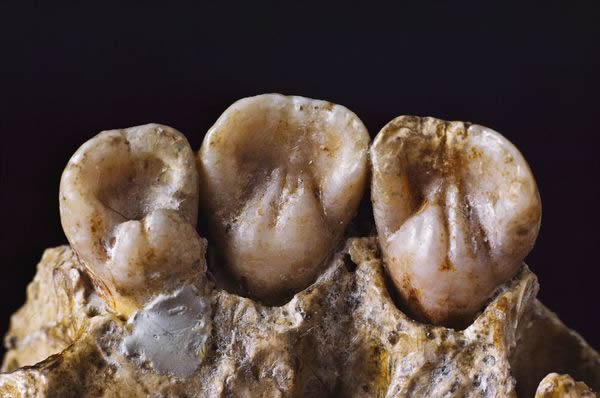Neanderthal Gums Relieved by Toothpicks
Neanderthals didn't like food between their teeth, much like humans.
Were Neanderthals merely lumbering oafs? Not at least as far as dental hygiene is concerned, archaeologists suggest.
Toothpicks likely were on the menu after a hearty Neanderthal meal.
Our long-lost Homo neanderthalensis cousins used the toothpicks to clean their teeth and even relieve the pain of gum disease, suggests a team at Spain's Institut Català de Paleoecologia Humana i Evolució Social (IPHES).
The practice, one suspects, likely beat using a spear.
The study, published in the October 16 issue of PLOS One, provides the oldest evidence of toothpick use for the purpose of pain relief.
Found at the Cova Foradà site in Valencia, Spain, the fossil teeth were embedded in the upper jaw of an ancient skull, which researchers estimate at 50,000 to 150,000 years old.
Gritty Diet
The teeth were free of cavities but showed heavy dental wear. This was likely due to a highly abrasive diet that probably included "stems, fruits, leaves, etc., and a great amount of meat and also marrow," said study lead author Marina Lozano of IPHES, by email.
"Also, all these foods would have dust and/or ashes that increased the abrasiveness of the diet" significantly, she added.
The toothpicks were most likely thin sticks or rigid stalks of grass.
An Ancient Pastime
That Neanderthals may have used toothpicks isn't a novel idea. Humans have been picking at their teeth since we've had teeth to pick, suggests evidence of toothpick use among hominins.
Such research has shown evidence of toothpick marks as far back as Homo habilis, an early human species that lived 1.6 to 1.9 million years ago. For Neanderthals it was presumably no different.
"For close to two million years, our ancestors have felt the need to pick out the gunk that gets stuck between their teeth," said biological anthropologist Leslea Hlusko of the University of California, Berkeley, who was not part of the new study.
"It's pretty neat to think that the fossilized creature you are holding in your hands—or looking at in these photos—had exactly the same problem that I just had after finishing lunch."
Neanderthal Dentistry Detected?
What's different here is that the new study suggests that Neanderthals were doing more than just de-gunking their molars.
The fossils displayed evidence of periodontal disease, along with telltale toothpick marks.
That led the researchers to hypothesize that Neanderthals employed toothpicks not just to clean teeth and dislodge food particles, but also to help relieve pain and inflammation caused by gum disease.
"A very severe gingivitis affected the bone, and the discomfort and pain of this individual would be important," said Lozano.
"The toothpick was used to extract food debris impacted between adjacent teeth, and also [by] introducing the toothpick he or she [would have] felt some mitigation of the pain."
According to the study, "The use of toothpicks of plant origin to mitigate sore gums could also be considered as a type of rudimentary dental treatment."
Neanderthal Know-How
If the toothpick finding bears out, it would be the oldest evidence of palliative dental care of its kind. And it would suggest that the Neanderthal was no technological slouch.
"Neanderthals developed a large and varied tool kit with wood and with stone," said Lozano. Neanderthals developed their own Mousterian class of stone tools, such as scrapers and blades used to cut meat, vegetables, and wood.
There's even been some evidence that Neanderthals made use of medicinal plants. If accurate, the new findings would constitute another addition to that tool kit and would contribute to mounting evidence that Neanderthals were more astute than previously realized.
And they probably had brighter smiles.
Stefan Sirucek
National Geographic
Published October 23, 2013












